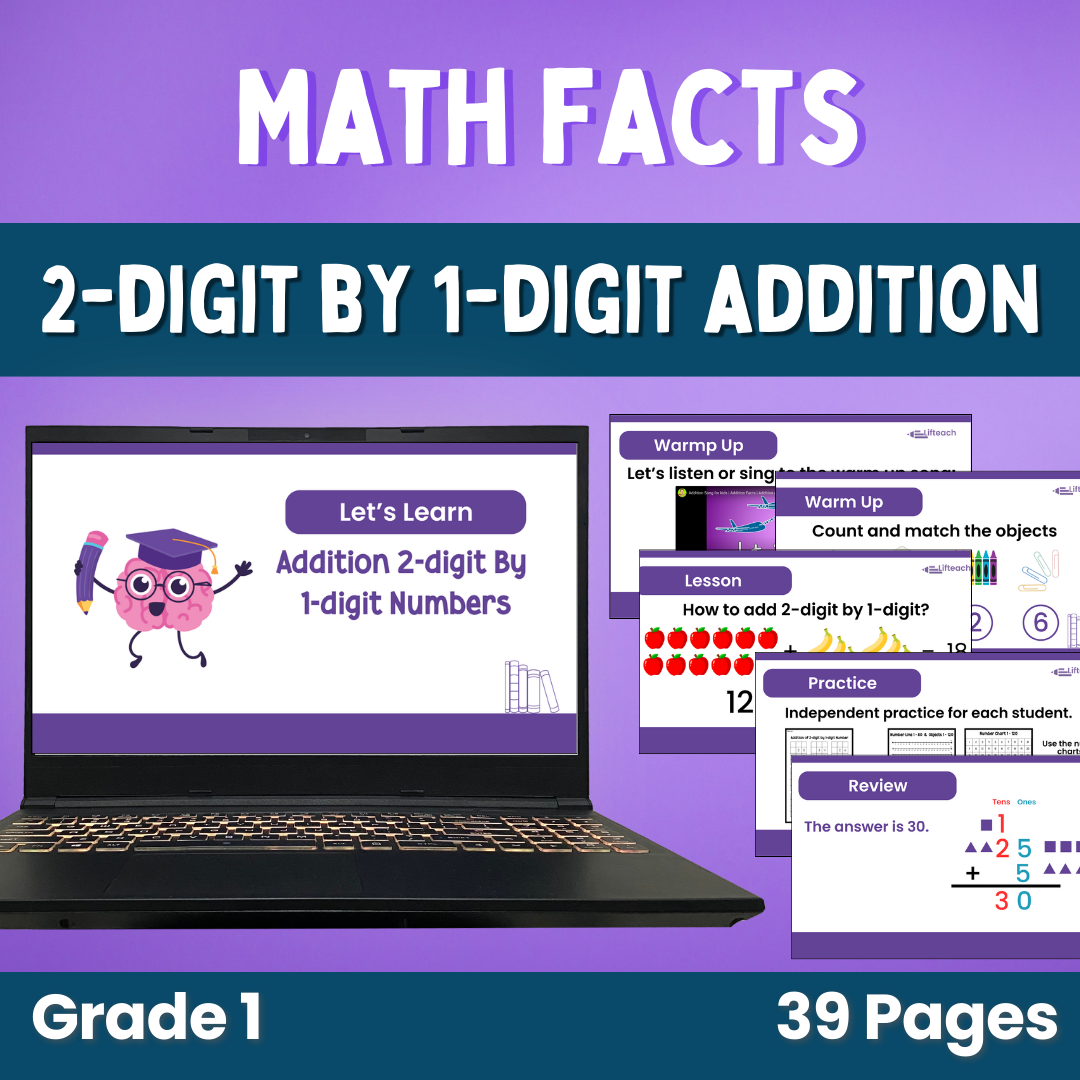Lesson Plan: Addition of 2-digit Numbers by 1-Digit Numbers
Grade Level: Grade 1
Subject: Math
Duration: 50 minutes
1. Learning Objectives
-
Students will be able to add a 2-digit number and a 1-digit number with a sum no greater than 99.
- Students will be able to demonstrate understanding by using various strategies such as counting on, using a number line, and drawing models.
-
Students will be able to solve word problems that involve adding 2-digit and 1-digit numbers.
2. Standards Alignment
- Common Core State Standards (CCSS) for Mathematics:
- CCSS.MATH.CONTENT.1.NBT.B.5: Add within 100, including adding a 2-digit number and a 1-digit number.
- CCSS.MATH.CONTENT.1.OA.A.1: Use addition and subtraction within 20 to solve word problems.
3. Instructional Activities and Teaching Strategies
Introduction (10 minutes)
Hook: Begin the lesson with a short interactive counting game where students count objects in groups (e.g., counting apples).
Discussion: Introduce the concept of adding 2-digit and 1-digit numbers. Use examples and relate them to real-life situations, such as adding apples and oranges.
Direct Instruction (15 minutes)
Demonstration: Use a chart or whiteboard to model how to add a 2-digit number and a 1-digit number. – Use the number 25 + 5 as an example. Show how to break down the addition (25 + 5 = 28).- Highlight key steps and strategies (e.g., counting on, regrouping if necessary).
Guided Practice (10 minutes)
Group Work: Divide students into small groups and give each group a set of 2-digit and 1-digit number cards.
Activity: Have students take turns drawing cards and solving the addition problems using manipulatives (e.g., counters, blocks) and number lines.
Independent Practice (10 minutes)
Worksheet: Distribute a worksheet with addition problems that involve 2-digit and 1-digit numbers.
Encourage students to use drawings or number lines to solve the problems.
4. Closure (5 minutes)
Review: Gather students and ask a few volunteers to share their answers and strategies used. Reinforce the different methods of adding.
Exit Ticket: Each student writes down one addition problem they solved and one method they used.
Required Materials and Resources
- Counting objects (e.g., counters, blocks, apples)
- Number cards (2-digit and 1-digit)
- Whiteboard and markers
- Chart paper for demonstration
- Worksheets for independent practice
- Number lines
Assessment Methods
- Formative Assessment: Observe student participation during discussions and group work, and provide immediate feedback.
- Worksheet: Evaluate the independent practice worksheets to assess individual understanding of the addition concepts.
- Exit Ticket: Review exit tickets to gauge student comprehension and identify any areas needing reteaching.
Differentiation Strategies for Diverse Learners
- For advanced learners: Provide more challenging problems that include larger 2-digit numbers or introduce simple 2-digit addition with carrying.
- For struggling learners: Use manipulatives more extensively and pair them with peer buddies for support during group work.
- Visual learners: Incorporate visual aids such as number lines and charts to enhance understanding.
- Kinesthetic learners: Include movement by having students physically act out additional problems using objects.
5. Timeline for Lesson Components
| Time | Activity |
| 0-10 min | Introduction (Hook & Discussion) |
| 10-25 min | Direct Instruction (Modeling & Vocabulary) |
| 25-35 min | Guided Practice (Pair Activity) |
| 35-45 min | Independent Practice (Worksheet & Closure) |
| 45-50 min | Closure |
Notes:
- Ensure the classroom environment is supportive and encourages collaboration.
- Adapt teaching strategies based on real-time student feedback and understanding.


